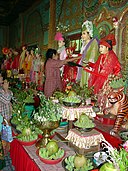Thagyamin
| Thagyamin | |
|---|---|
 The sculpture of Thagyamin In position of chief of nat in Shwezigon Pagoda in Pagan Kingdom. [1][2][3] | |
| Affiliation | deva , nat , Buddhism in Myanmar, Burmese folk religion |
| Abode | Amarāvati, the capital of Indraloka (Indra's world) in Svarga,[4] Trāyastriṃśa (Heaven of the 33), Mount Meru |
| Weapon | Vajra (Thunderbolt), Astras, Vasavi Shakthi |
| Symbols | Vajra, Indra's net |
| Mount | Airavata (White elephant), Uchchaihshravas (White horse) |
| Texts | deva , nat , Buddhism in Myanmar, Burmese folk religion, Jātakas, Epics |
| Consort | Sujā (Buddhism) |
| Equivalents | |
| Greek | Zeus |
| Norse | Thor |
| Roman | Jupiter |
| Slavic | Perun |

Thagyamin (Template:Lang-my, pronounced [ðədʑámɪ́ɴ]; from Sanskrit Template:My Śakra) is the highest-ranking nat in traditional Burmese Buddhist belief. Considered king of the second heaven above Catumaharcika, he is derived from the Buddhist deva Śakra and the Hindu deity Indra.[5]
Description
Thagyamin is often portrayed as holding a conch shell in one hand, and a yak-tail fly-whisk in the other, and seated or standing atop a three-headed white elephant (similar to the Thai Erawan).[5] He is described as the ruler of the deva plane of existence, called Trāyastriṃśa (Template:My).
He was designated the preeminent of the official pantheon of 37 atet nat (အထက်နတ်) by King Anawrahta in the 11th century, in an effort to streamline animist practices among the populace and merge these practices with Theravada Buddhism. He is the only nat in the official pantheon not to have undergone a sudden and violent death, called a "green" or "raw" death (စိမ်းသေ).
Gallery
-
A portrayal of the King of Nats, Thagyamin
-
Thagyamin at the Shwedagon Pagoda
See also
Counterparts of Thagyamin in other Asian cultures
- Amenominakanushi, the Japanese counterpart
- Haneullim, the Korean counterpart of Yuanshi Tianzun
- Indra, the Hindu counterpart
- Jade Emperor, the Chinese counterpart
- Śakra, the Buddhist counterpart
- Tengri, the Mongolian counterpart
- Yuanshi Tianzun, the Taoist counterpart
References
- ^ http://www.craigandstephsvacations.com/Myanmar/2016/Myanmar20161102More.html
- ^ https://www.alamy.com/stock-photo/king-of-burma.html
- ^ http://seasite.niu.edu/burmese/Cooler/Chapter_3/Part2/pagan_period_2.htm
- ^ Dalal, Roshen. Hinduism: an Alphabetical Guide. Penguin Books, 2014, books.google.com/books?id=zrk0AwAAQBAJ&pg=PT561&lpg=PT561&dq=indraloka+hinduism&source=bl&ots=n_TDE8_SQn&sig=b4a5vg6wUlkqPxwC5mfJkeHKP5A&hl=en&sa=X&ved=2ahUKEwjOvPTWl7zbAhWKr1kKHXUzAUoQ6AEwEnoECAMQAQ#v=onepage&q=indraloka%20hinduism&f=false.
- ^ a b Hla Tha Mein. "Thirty-Seven Nats". Yangonow. Archived from the original on 2006-06-24. Retrieved 2006-07-03.



